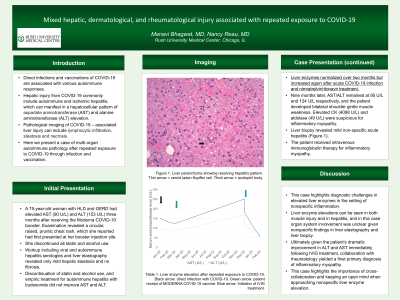Sunday Poster Session
Category: Liver
P1047 - Mixed Hepatic, Dermatological, and Rheumatological Injury Associated With Repeated Exposure to COVID-19
Sunday, October 22, 2023
3:30 PM - 7:00 PM PT
Location: Exhibit Hall

Has Audio

Manavi Bhagwat, MD
Rush University Medical Center
Chicago, IL
Presenting Author(s)
Manavi Bhagwat, MD, Nancy Reau, MD
Rush University Medical Center, Chicago, IL
Introduction: Coronavirus disease 2019 (COVID-19) exposure through both direct infection and vaccination is associated with a wide range of autoimmune responses. Types of hepatic injury from COVID-19 include autoimmune hepatitis (AIH) and ischemic hepatitis. Frequently observed serum liver derangements include a hepatocellular pattern of aspartate aminotransferase (AST) and alanine aminotransferase (ALT) elevation. Pathological imaging of COVID-19 – associated liver injury can include lymphocytic infiltration, mild steatosis and hepatic necrosis. Here we present a case of multi-organ autoimmune pathology that developed after repeated exposure to COVID-19 through infection and vaccination.
Case Description/Methods: A 75-year-old woman with hyperlipidemia and gastrointestinal reflux disease had elevated AST (90 U/L) and ALT (153 U/L) three months after receiving the Moderna COVID-19 booster. Examination revealed a circular, raised, pruritic chest rash, which she reported had first presented at her booster injection site. She discontinued all statin and alcohol use. Viral and AIH workup was negative. Liver elastography revealed no fibrosis and mild hepatic steatosis. Empiric treatment for AIH with budesonide did not improve AST and ALT. Liver enzymes normalized over two months but began increasing again after the patient developed acute COVID-19 infection and received nirmatrelvir/ritonavir treatment. Nine months later, AST/ALT remained elevated at 95 U/L and 124 U/L respectively, and the patient developed bilateral shoulder girdle muscle weakness. Elevated creatine kinase (4098 U/L) and aldolase (49 U/L) were suspicious for inflammatory myopathy. Rash biopsy was concerning for autoimmune process. Liver biopsy revealed mild non-specific acute hepatitis. Bilirubin, prothrombin time, and alkaline phosphatase levels remained normal throughout. Intravenous immunoglobulin therapy was administered for inflammatory myopathy.
Discussion: This is the first documented case of liver injury associated with COVID-19 exposure that contributes to a multi-organ autoimmune process. Though AST and ALT elevations can be seen in muscle injury, liver elastography and liver biopsy confirmed hepatic involvement. Given worsening symptoms with repeated COVID-19 exposure, prior autoimmune reactions should be reviewed when considering future COVID-19 booster doses. Patient history of other autoimmune reactions to COVID-19 should raise clinician suspicion for viral exposure as an etiology for unexplained hepatitis.
Disclosures:
Manavi Bhagwat, MD, Nancy Reau, MD. P1047 - Mixed Hepatic, Dermatological, and Rheumatological Injury Associated With Repeated Exposure to COVID-19, ACG 2023 Annual Scientific Meeting Abstracts. Vancouver, BC, Canada: American College of Gastroenterology.
Rush University Medical Center, Chicago, IL
Introduction: Coronavirus disease 2019 (COVID-19) exposure through both direct infection and vaccination is associated with a wide range of autoimmune responses. Types of hepatic injury from COVID-19 include autoimmune hepatitis (AIH) and ischemic hepatitis. Frequently observed serum liver derangements include a hepatocellular pattern of aspartate aminotransferase (AST) and alanine aminotransferase (ALT) elevation. Pathological imaging of COVID-19 – associated liver injury can include lymphocytic infiltration, mild steatosis and hepatic necrosis. Here we present a case of multi-organ autoimmune pathology that developed after repeated exposure to COVID-19 through infection and vaccination.
Case Description/Methods: A 75-year-old woman with hyperlipidemia and gastrointestinal reflux disease had elevated AST (90 U/L) and ALT (153 U/L) three months after receiving the Moderna COVID-19 booster. Examination revealed a circular, raised, pruritic chest rash, which she reported had first presented at her booster injection site. She discontinued all statin and alcohol use. Viral and AIH workup was negative. Liver elastography revealed no fibrosis and mild hepatic steatosis. Empiric treatment for AIH with budesonide did not improve AST and ALT. Liver enzymes normalized over two months but began increasing again after the patient developed acute COVID-19 infection and received nirmatrelvir/ritonavir treatment. Nine months later, AST/ALT remained elevated at 95 U/L and 124 U/L respectively, and the patient developed bilateral shoulder girdle muscle weakness. Elevated creatine kinase (4098 U/L) and aldolase (49 U/L) were suspicious for inflammatory myopathy. Rash biopsy was concerning for autoimmune process. Liver biopsy revealed mild non-specific acute hepatitis. Bilirubin, prothrombin time, and alkaline phosphatase levels remained normal throughout. Intravenous immunoglobulin therapy was administered for inflammatory myopathy.
Discussion: This is the first documented case of liver injury associated with COVID-19 exposure that contributes to a multi-organ autoimmune process. Though AST and ALT elevations can be seen in muscle injury, liver elastography and liver biopsy confirmed hepatic involvement. Given worsening symptoms with repeated COVID-19 exposure, prior autoimmune reactions should be reviewed when considering future COVID-19 booster doses. Patient history of other autoimmune reactions to COVID-19 should raise clinician suspicion for viral exposure as an etiology for unexplained hepatitis.
Disclosures:
Manavi Bhagwat indicated no relevant financial relationships.
Nancy Reau: Abbott – Advisory Committee/Board Member. AbbVie – Advisory Committee/Board Member. Arbutus – Advisor or Review Panel Member. Gilead – Advisory Committee/Board Member. Salix – Advisory Committee/Board Member.
Manavi Bhagwat, MD, Nancy Reau, MD. P1047 - Mixed Hepatic, Dermatological, and Rheumatological Injury Associated With Repeated Exposure to COVID-19, ACG 2023 Annual Scientific Meeting Abstracts. Vancouver, BC, Canada: American College of Gastroenterology.
